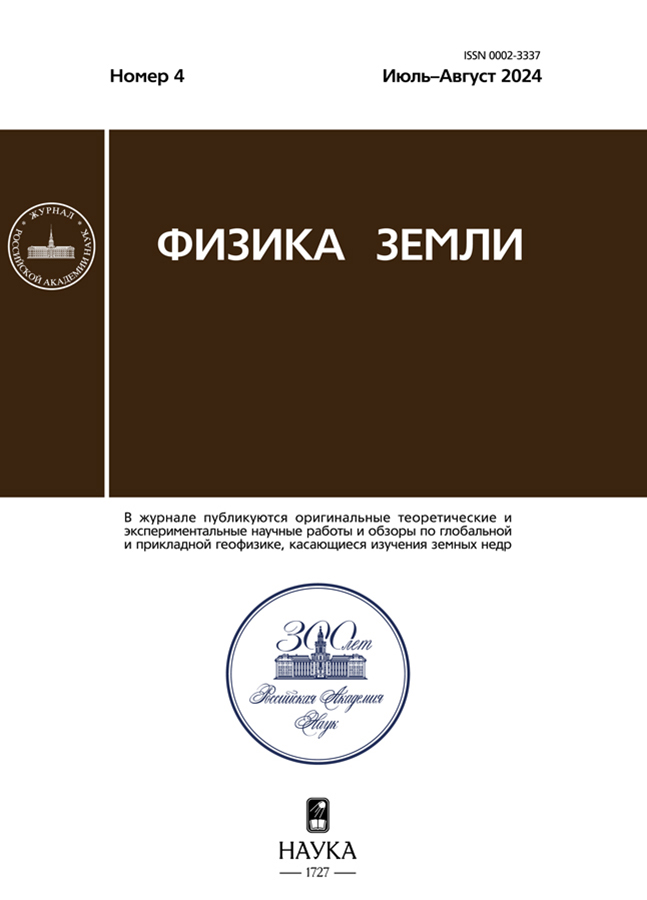Characteristic Ddepth distribution of crustal earthquakes in Southern Siberia
- Авторлар: Malyutin P.A.1,2,3, Skorkina A.A.1, Vorobieva I.A.1,4, Baranov S.V.1,5, Matochkinaa S.D.1,2, Molokova A.P.1,2, Shebalin P.N.1,6
-
Мекемелер:
- Institute of Earthquake Prediction Theory and Mathematical Geophysics, Russian Academy of Sciences
- Moscow State University
- Schmidt Institute of Physics, Russian Academy of Science
- Geophysical Center, Russian Academy of Sciences,
- Kola Branch, Geophysical Survey, Russian Academy of Sciences
- Geophysical Center, Russian Academy of Sciences
- Шығарылым: № 4 (2024)
- Беттер: 50-63
- Бөлім: Articles
- URL: https://journals.eco-vector.com/0002-3337/article/view/658167
- DOI: https://doi.org/10.31857/S0002333724040046
- EDN: https://elibrary.ru/FWVLJX
- ID: 658167
Дәйексөз келтіру
Аннотация
The key parameters of an earthquake are magnitude, epicenter coordinates, and depth. Depth often has a decisive influence on the macroseismic effect of certain earthquakes. In this regard, for example, to assess seismic risk, one should know information on the statistics of earthquake occurrence at certain depths. In this work, catalogs of continental crustal earthquakes in the Southern Siberia are analyzed. The distributions of earthquake depths are approximated by various functions. The Weibull distribution, with a maximum at 8 km, is shown to describe the depth distribution of these crustal earthquakes most accurately. When the western (Altai–Sayan) and eastern (Baikal Rift Zone) parts of the region are considered separately, the Weibull distribution is also preferable. The maximum of the distribution is found to be at 9 km for the Baikal rift zone and at 7 km for the Altai–Sayan zone.
Толық мәтін
Авторлар туралы
P. Malyutin
Institute of Earthquake Prediction Theory and Mathematical Geophysics, Russian Academy of Sciences; Moscow State University; Schmidt Institute of Physics, Russian Academy of Science
Хат алмасуға жауапты Автор.
Email: pavel@mitp.ru
Faculty of Physics of the Earth
Ресей, 117997 Moscow; 119991 Moscow; 123242 MoscowA. Skorkina
Institute of Earthquake Prediction Theory and Mathematical Geophysics, Russian Academy of Sciences
Email: pavel@mitp.ru
Ресей, Moscow, 117997
I. Vorobieva
Institute of Earthquake Prediction Theory and Mathematical Geophysics, Russian Academy of Sciences; Geophysical Center, Russian Academy of Sciences,
Email: pavel@mitp.ru
Ресей, 117997 Moscow; Moscow, 119296
S. Baranov
Institute of Earthquake Prediction Theory and Mathematical Geophysics, Russian Academy of Sciences; Kola Branch, Geophysical Survey, Russian Academy of Sciences
Email: pavel@mitp.ru
Ресей, 117997 Moscow; Apatity, 184209
S. Matochkinaa
Institute of Earthquake Prediction Theory and Mathematical Geophysics, Russian Academy of Sciences; Moscow State University
Email: pavel@mitp.ru
Faculty of Physics of the Earth
Ресей, 117997 Moscow; 119991 MoscowA. Molokova
Institute of Earthquake Prediction Theory and Mathematical Geophysics, Russian Academy of Sciences; Moscow State University
Email: pavel@mitp.ru
Faculty of Physics of the Earth
Ресей, 117997 Moscow; 119991 MoscowP. Shebalin
Institute of Earthquake Prediction Theory and Mathematical Geophysics, Russian Academy of Sciences; Geophysical Center, Russian Academy of Sciences
Email: pavel@mitp.ru
Ресей, Moscow, 117997; Moscow, 119296
Әдебиет тізімі
- Абубакиров И.Р., Павлов В.М. Определение тензора момента двойного диполя для землетрясений Камчатки по волновым формам региональных сейсмических станций // Физика Земли. 2021. №. 3. С. 45–62.
- Виноградов Ю.А. Состояние системы сейсмологических наблюдений в России и перспективы ее развития. Современные методы обработки и интерпретации сейсмологических данных. 2023. С. 3.
- Землетрясения России в 2021 году. Обнинск: ФИЦ ЕГС РАН. 2023. 224 с. ISSN 1819-852X.
- Землетрясения Северной Евразии. 2022. Вып. 25 (2016–2017 гг.). 392 c. ISSN 1818–6254.
- Кустова М.Г., Радзиминович Н.А. Результаты релокализации гипоцентров афтершоков землетрясения 16.09. 2003 г. с MS = 5.8 с эпицентром на северо-восточном фланге БРЗ. Геология, поиски и разведка полезных ископаемых и методы геологических исследований. 2006. С. 24–28.
- Лукк А.А., Леонова В.Г. Распределение с глубиной очагов землетрясений как проявление природы деформирования континентальной коры // Геофизические процессы и биосфера. 2020. Т. 19. № 1. С. 30–50.
- Писаренко В.Ф., Ружич В.В., Скоркина А.А., Левина Е.А. Структура сейсмического поля Байкальской рифтовой зоны // Физика Земли. 2022. № 3. С. 37–55.
- Пояснительная записка к комплекту карт общего сейсмического районирования территории Российской Федерации ОСР 2016 / В.И. Уломов, М.И. Богданов (ред.) // Инженерные изыскания. 2016. № 7. С. 49–122.
- Радзиминович Н.А. Глубины очагов землетрясений Байкальского региона: обзор // Физика Земли. 2010. № 3. С. 37–51.
- Шебалин П.Н., Гвишиани А.Д., Дзебоев Б.А., Скоркина А.А. Почему необходимы новые подходы к оценке сейсмической опасности? // Докл. РАН. 2022. Т. 507(1). С.91–97.
- Abercrombie R. E., Mori J. Occurrence patterns of foreshocks to large earthquakes in the western United States // Nature. 1996. V. 381. № 6580. P. 303–307.
- Albaric J., Deverchere J., Perrot J., Jakovlev A., Deschamps A. Deep crustal earthquakes in North Tanzania, East Africa: Interplay between tectonic and magmatic processes in an incipient rift // Geochemistry, Geophysics, Geosystems. 2014. V. 15. № 2. P. 374–394.
- Bondár I., Myers S.C., Engdahl E.R., Bergman E.A. Epicentre accuracy based on seismic network criteria // Geophysical Journal International. 2004. V. 156. № 3. P. 483–496.
- Cole J., Hacker B., Ratschbacher L., Dolan J., Seward G., Frost E., Frank W. Localized ductile shear below the seismogenic zone: Structural analysis of an exhumed strike-slip fault, Austrian Alps // J. Geophys. Res. 2007. V. 112. B12304.https://doi.org/10.1029/2007JB004975
- Deverchere J., Houdry F., Solonenko N.V., Solonenko A.V., Sankov V.A. Seismicity, active faults and stress field of the North Muya region, Baikal rift: new insights on the rheology of extended continental lithosphere // J. Geophys. Res. 1993. V. 98. P. 19 895–19 912.
- Déverchère J., Petit C., Gileva N., Radziminovitch N., Melnikova V., San’kov V. Depth distribution of earthquakes in the Baikal rift system and its implications for the rheology of the lithosphere // Geophysical Journal International. 2001. V. 146. № 3. P. 714–730.
- Doglioni C., Barbab S., Carminatia E., Riguzzi F. Role of the brittle–ductile transition on fault activation // Phys. Earth Planet. Inter. 2011. V. 184. № 3–4. P. 160–171. https://doi. org/10.1016/j.pepi.2010.11.005
Қосымша файлдар













